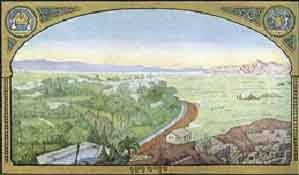Crossing the Threshold
Essential Purpose
About 10,000 years ago, humans began to produce their food in a more systematic way – through agriculture. The shift toward agriculture happened gradually over a long period of time, independently on all continents, except Australia. For the vast majority of history, humans lived as hunters and gatherers. The emergence of farming resulted in a whole new way of living. By producing food more systematically, humans were able to live together in greater numbers and greater density than ever before. But such growth in population also required new ways of social organization.

Jericho, one of the earliest farming towns in the world
National History Standards
Era 1: The Beginnings of Human Society
Standard 2: The processes that led to the emergence of agricultural societies around the world.
Standard 2A: The student understands how and why humans established settled communities and experimented with agriculture.
-
- Infer from archaeological evidence the technology, social organization, and cultural life of settled farming communities in Southwest Asia.
- Identify areas in Southwest Asia and the Nile valley where early farming communities probably appeared and analyze the environmental and technological factors that made possible experiments with farming in these regions.
Standard 2B: The student understands how agricultural societies developed around the world.
-
- Analyze differences between hunter gatherer and agrarian communities in economy, social organization, and quality of living.
- Analyze archaeological evidence from agricultural village sites in Southwest Asia, North Africa, China, or Europe indicating the emergence of social class divisions, occupational specializations, and differences in the daily tasks that men and women performed.
-
- Assess archaeological evidence for long-distance trade in Southwest Asia.
State/Local Standards
States should align these modules to their own state/local standards as appropriate.
Essential Questions
- How did humans live for most of history and why did they maintain this way of life for so long?
- Where did agricultural communities arise and how did their development lead to the rise of complex societies?
- What are the distinguishing characteristics of complex societies?
Essential Content
Hunting and Gathering
- Hunting and gathering was the way of life for humans for tens of thousands of years – far longer than the existence of any other way of life.
- The transition from hunting and gathering to agriculture occurred first in places where hunting and gathering could no longer sustain the population due to population pressures and/or changing environments.
Complex Societies
- In some places, the gradual transition from hunting and gathering to agriculture led to the development of complex societies.
- Characteristics of a complex society may include: the development of cities, specialization of labor, organized government and religious institutions, social classes, long distance trade, and the development of written language or other means of keeping records.
- In some places the transition from hunting and gathering to agriculture did not lead to the development of complex societies. In those places, the plants and animals available for domestication did not provide a surplus that could be stored and/or the cultivation of crops was so labor intensive that it did not allow for the specialization of labor.
The need for communities to work cooperatively in order to make the most productive use possible of their environment further spurred the early development of some highly complex societies.
Essential Skills
Standard 3: Historical Analysis and Interpretation
- Analyze cause-and-effect relationships and multiple causations, including the importance of the individual, the influence of ideas, and the role of chance.
- Hypothesize the influence of the past.
Standard 5: Historical Issues-Analysis and Decision-Making
- Identify issues and problems in the past.
- Marshal evidence of antecedent circumstances and contemporary factors contributing to problems and alternative courses of action.
- Identify relevant historical antecedents.
- Evaluate alternative courses of action.
- Formulate a position or course of action on an issue.
- Evaluate the implementation of a decision.
Summative Assessment
This summative assessment and scoring guide should be reviewed with students prior to using the activities in the module. Students should do the assessment after the activities have been completed.
Essential Questions Addressed by the Summative Assessment:
- Why have civilizations changed slowly over time with more rapid changes occurring during the modern era?
- Where did agricultural communities arise and how did their development lead to the rise of complex societies?
- What are the distinguishing characteristics of complex societies?
|
Connection to Prior Knowledge
Problem
Role/
Perspective Product/ Performance
Criteria for an Exemplary Response
|
Now that you have learned the distinguishing characteristics of a complex society, you are ready to analyze an excavation site to see if this site gives evidence of being a complex society.
Artifacts have recently been found that appear to have come from a previously unknown agrarian settlement. Since the artifacts first appeared for sale on the illegal black market for ancient art, the exact location of their discovery is unknown. However, there is evidence that the artifacts originated somewhere in the region shown on the map. A university has agreed to sponsor a summer expedition to find this lost civilization. The university has provided only enough time and money to excavate one site in the region. You are an archaeologist working for the university. As head of the archaeology department, you have been given the opportunity to lead the expedition. After careful consideration, you have selected a site which you think will yield evidence of a complex society. After excavating the site, you are anxious to write a brief report telling the university’s Board of Trustees why you have made a wise decision to excavate this particular site. Review the Summary of Archaeological Findings and also photographs of artifacts from this site. Analyze this evidence and use it in your report to support your conclusion. In your report, be sure to:
|



